"Where tides of grass break into foam of flowers,
Or where the wind's feet shine along the sea."
- Swinburne
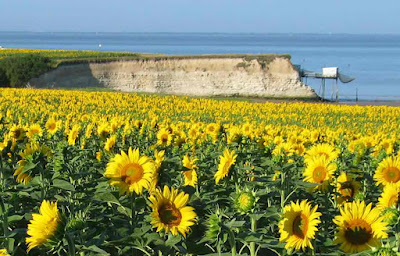 |
| An iconic view of the Gironde Estuary |
Limestone cliffs, fishing huts perched on stilts and rolling fields of sunflowers... this may well be the lasting image that many holiday-makers take home with them.
Add to that the familiar sound of skylarks, singing madly as they flutter high upon a hill; or young buzzards mewing plaintively over the valleys, while insects chirrup and hum in grass verges. Contentment reigns.
Add to that the familiar sound of skylarks, singing madly as they flutter high upon a hill; or young buzzards mewing plaintively over the valleys, while insects chirrup and hum in grass verges. Contentment reigns.
 |
| Vines interspersed with sunflowers |
Another typical view of the landscape on our doorstep shows a path linking two parts of our village - Chenac and Petit Chenac.
Locals still farm their inherited plots, accounting for the variegated patchwork of small fields and vineyards - which some might deem hopelessly romantic and impractical, but provide no end of inspiration for pictures.
I'm very happy to say that sunflowers are still a popular crop in these parts, though I hear that in other areas they're being supplanted by the far less appealing soya bean.
 |
| Neighbour with a sunny outlook |
Charente Maritime
This is the name of our coastal département in southwest France which has recently been incorporated into the large administrative area of Nouvelle Aquitaine - 'old' Aquitaine having once belonged to England (for 300 years!) until reverting to France in 1453.
I read the other day that Charente Maritime is now the number one holiday destination for the French - surprising really, as many claim not to know where it is, although most have heard of its capital, the port of La Rochelle.
 |
| Sailboat on the Gironde Estuary |
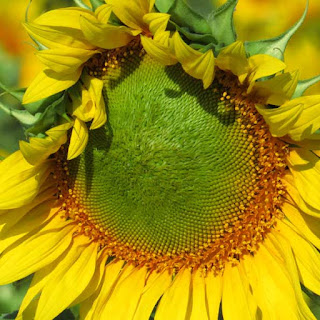 |
| Early development of a sunflower, reflecting an almost metallic sheen |
 |
| Freshly baled field |
These shots are all taken within walking distance of our holiday cottage, La Maree, which is popular with couples and small families who enjoy walking and cycling along the rural pathways.
There's nothing quite like cycling past sunflowers to collect your fresh croissant from the boulangerie for breakfast!
Early mornings are the best time to get out and about, enjoying that slight nip in the air before the sun really puts its hat on. But here on the coast it rarely becomes unpleasantly hot or humid because the breeze is never far away - by midday it's usually flapping the parasol and can be quite gusty by 5pm when the day is hottest.
The abundance of seed on sunflowers has led to local production of sunflower oil - huile de tournesol - an excellent alternative to olive oil and better for cooking purposes.
Seeds are also favoured by a number of different birds and insects, including the scarily large carpenter bee which is very big but quite harmless. Indeed it has wonderful blue-black wings which make a striking contrast with the golden flowers.
Once the seeds have matured, finches take the opportunity to swoop down and enjoy a nutritious feast.
Early mornings are the best time to get out and about, enjoying that slight nip in the air before the sun really puts its hat on. But here on the coast it rarely becomes unpleasantly hot or humid because the breeze is never far away - by midday it's usually flapping the parasol and can be quite gusty by 5pm when the day is hottest.
 |
| Natural companions - interspersed with hedge parsley |
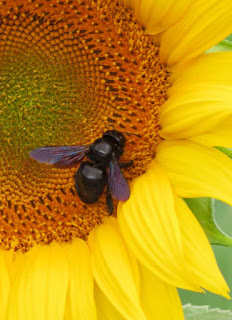 |
| Carpenter bee (Xylocopa violacea) |
Seeds are also favoured by a number of different birds and insects, including the scarily large carpenter bee which is very big but quite harmless. Indeed it has wonderful blue-black wings which make a striking contrast with the golden flowers.
Once the seeds have matured, finches take the opportunity to swoop down and enjoy a nutritious feast.
 |
| Bad hair day? |
As July burns into August, these seed heads become ever more pronounced and petals start to look distinctly bedraggled...
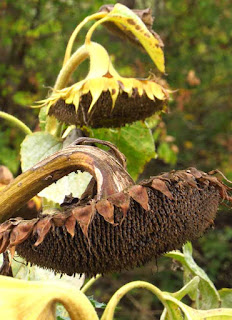 |
| The end of summer is nigh... |
By September they are really browned-off, hanging their heads in shame at having lost their sunny radiance.
The stems turn a sort of plasticky yellow, then gradually morph to chocolate-brown as they dry out - along with their seeds which become almost black.
Now when you walk past these fields, you're aware of the creepy rustling of dried leaves as an early autumn breeze begins to whisper through the plantation.
Your imagination can easily conjure up scary shapes of the 'undead' - very Stephen King!
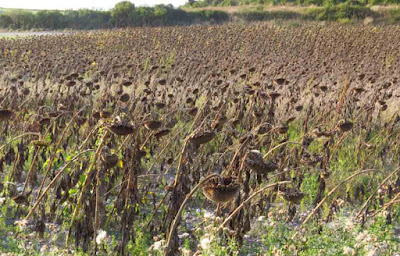 |
| By late September the Grim Reaper is on his way! |

No comments:
Post a Comment